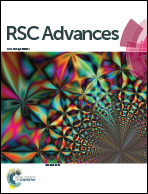Human serum albumin (HSA) coated liposomal indocyanine green for in vivo tumor imaging†
Abstract
In this study, a near-infrared (NIR) fluorescent nanoprobe based on indocyanine green (ICG) was synthesized. In comparison with ICG solution, the resulting nanoprobe, namely HSA–lipid–ICG NPs, exhibited remarkable improvement in stability as well as higher NIR fluorescence intensity. The in vitro experimental results demonstrated that HSA–lipid–ICG NPs were nontoxic at physiologically relevant concentrations and could be efficiently uptaken by MCF-7 cells through endocytosis after 0.5 h incubation. The biodistribution of HSA–lipid–ICG NPs was evaluated in a mouse xenograft model. An optimized tumor contrast was observed after 8 h intravenous administration, while ICG solution had negligible effect. The tumor could be clearly detected and the signal lasted at least up to 24 h after injection. This nanoprobe may potentially serve as an ideal contrast agent for in vivo NIR fluorescence imaging.


 Please wait while we load your content...
Please wait while we load your content...